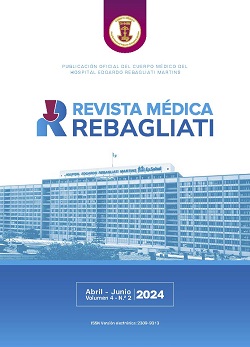Congenital malformations associated with Downsyndrome in newborns from a national referencehospital: Experience of a Birth defect registry
DOI:
https://doi.org/10.70106/rmr.v4i2.26Keywords:
Down's Syndrome, birth defects; trisomy 21Abstract
Objective: Down syndrome is the most common chromosomal abnormality in newborns and the first genetic cause of intellectual disability. The objective of this study was to describe associated birth defects with Down syndrome in newborns at the Edgardo Rebagliati Martins Hospital (HNERM). Materials and methods: A descriptive, retrospective and cross-sectional
study was conducted. The study population consisted of 191 births diagnosed with Down
syndrome, during the period 2013-2017 of the registry of the Latin American Collaborative Study of Congenital Malformations (ECLAMC) of the HNERM. Results: In the study period, a total of 191 newborns with suspected Down syndrome were reported, of which 180 were
confirmed with karyotyping, out of a total of 34,326 live births. Free trisomy accounted for
98.9%, while mosaicism and translocation trisomy occurred in 0.6% of newborns. The median maternal age was 39 years (range 20-46 years). Congenital heart disease was observed in 61.7%, gastrointestinal malformation 10%, craniofacial malformation 5%, genitourinary 3.9%, musculoskeletal malformation 1.7% and central nervous system malformation 1.7%. Conclusions: The birth prevalence rate of Down syndrome in the study period was 52.4 per 10,000 births. The most frequent malformations associated with Down syndrome are congenital heart disease and secondly malformations of the gastrointestinal tract. Other less
frequently associated malformations are craniofacial, genitourinary, musculoskeletal and central nervous system malformations.
Downloads
Downloads
Published
Issue
Section
License
Copyright (c) 2024 Milagros M. Dueñas-Roque1, Rosario Gamarra-Díaz (Autor/a)

This work is licensed under a Creative Commons Attribution 4.0 International License.













